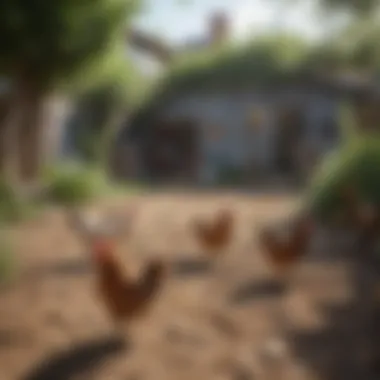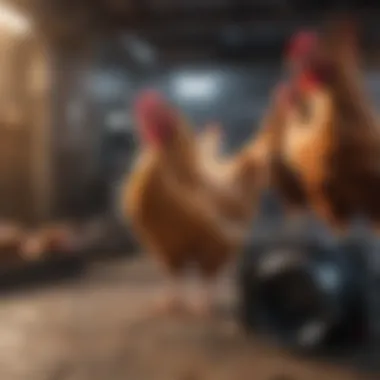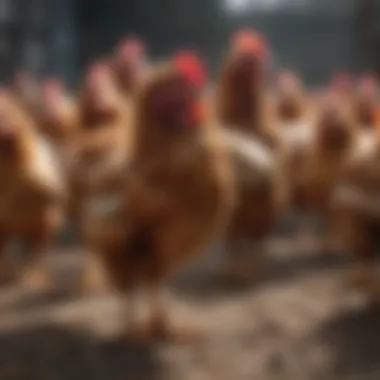Optimal Square Feet for Chickens in Poultry Farming


Intro
Understanding the square footage requirements for chickens is critical for both novice and experienced poultry farmers. The amount of space allocated directly affects the health, welfare, and productivity of the birds. Chickens, whether raised for eggs or meat, need adequate space to move around, exhibit natural behaviors, and access food and water comfortably.
In this article, we will explore how different factors influence the required square footage for chickens. We will examine chicken breeds, purposes for poultry farming, and innovative management practices affecting space needs. Additionally, both outdoor and indoor requirements will be discussed, alongside relevant regulations that must be adhered to. This resource aims to empower poultry enthusiasts making informed decisions to create optimal environments for their chickens.
Space Requirements for Chickens
Factors Influencing Space Needs
Several elements determine how much space chickens need:
- Breed Size: Larger breeds like Brahmas require more room than smaller ones such as Bantams.
- Purpose: Layers typically need slightly less space than broilers, as their primary goal is egg production rather than frequent movement.
- Age: Chicks require less space than fully grown chickens, but as they mature, their spatial needs increase.
Recommended Square Footage
According to best practices, the general guidance on square footage is:
- Indoor Space: A minimum of 4 square feet per bird is recommended.
- Outdoor Space: At least 10 square feet per bird is ideal for free-range scenarios.
Moving beyond strict numbers, the intention should be to ensure each chicken can express natural behaviors freely while minimizing stress and aggression within the flock. Providing ample space is crucial for reducing pecking and other negative behaviors that arise from overcrowding.
Regulations to Consider
Local laws and regulations can affect space requirements. Many areas enforce humane treatment standards that dictate minimum square footage and overall stocking densities. Ensuring compliance not only promotes animal welfare but also positions farmers favorably within their communities.
Closure
Determining the square footage needed for chickens is vital in creating a thriving poultry environment. By assessing factors like breed, purpose, and applicable regulations, farmers can develop effective housing plans that prioritize chicken welfare and productivity.
Prelude to Chicken Space Requirements
Understanding space requirements is essential for any chicken farming endeavor. Proper allocation of space affects overall growth, health, and productivity of the chickens. Overly crowded conditions can lead to various health issues and behavioral problems. Additionally, considering space not only benefits the birds but also contributes to the sustainability of the farm. A well-planned environment promotes optimal welfare and enhances efficiency on the farm.
Importance of Space in Chicken Farming
Space is critical in chicken farming for several reasons. First, adequate space allows chickens to express natural behaviors. Chickens thrive when they can move freely, perch, and forage without undue stress. Stress from overcrowding can lead to a variety of health concerns, such as respiratory illnesses and increased aggression.
Furthermore, appropriate space allocation reduces competition for resources such as food and water. When chickens have enough room, they can access essential nutrients easily, leading to better weight gain and egg production. Sufficient space also lowers the risk of disease transmission among birds, which is crucial for maintaining a healthy flock.
Lastly, compliance with animal welfare regulations increasingly emphasizes the importance of space. Farmers who understand and implement proper space standards will not only safeguard their livestock but also align with legal guidelines.
Factors Influencing Space Needs
Several factors can influence the amount of space needed for chickens. One major element is the breed of chicken. Different breeds, such as broilers and layers, have varied growth rates and space needs. For example, broilers are typically raised for meat and may require more space during their rapid growth phases, while layers may need less space but require proper nesting areas.
The age of chickens is another significant factor. Young chicks require less space initially, but as they grow, their space needs will increase. Additionally, the method of housing plays an important role. Free-range systems generally allow more space compared to caged systems. The layout of the coop and outdoor area can directly affect how chickens interact with one another and their environment.
Lastly, environmental conditions like climate and season should not be overlooked. For example, in colder climates, chickens may need more indoor space during winter months. Understanding these factors ensures that farmers allocate space appropriately for the well-being of their flock.
Understanding Square Feet and Its Importance


Understanding square feet in the context of poultry farming is fundamental. Space allocation directly impacts the well-being and productivity of chickens. This space not only serves as a physical location but also influences crucial aspects such as behavior, health, and growth. Proper understanding helps poultry owners create an environment where chickens can thrive. Poor space management can lead to stress among birds, which can result in health issues and reduced output.
Defining Square Feet in Poultry Farming
Square feet in poultry farming refers to the measurement of area available for the chickens, both indoors and outdoors. Common measures include the size of coops and the surrounding land allocated for foraging and roaming. The recommended square footage varies depending on several factors, such as the breed of chicken and the intended purpose, whether for meat or egg production.
For indoor spaces, guidelines often recommend a minimum of 2 to 4 square feet per chicken, depending on their size and breed. Larger breeds like Jersey Giants may require more space as compared to smaller breeds like Bantams. A well-defined area allows chickens to move freely, mitigating stress and aggressive behavior among them.
Calculating Space for Different Breeds
Calculating the appropriate space for different breeds involves understanding their specific needs and behaviors.
- Layers: These hens need sufficient space to lay eggs comfortably. Generally, it is advised to provide at least 3 square feet per layer chicken in the coop.
- Broilers: Typically meant for meat production, broilers may require around 2 square feet per bird indoors. However, allowing more room can improve their overall health and weight gain.
These calculations should not only factor in the birds' physical dimensions but also their social dynamics. It's essential to account for behavioral patterns such as pecking order, which can be more pronounced in crowded conditions.
Proper space allocation benefits the overall health and productivity of the flock and can lead to enhanced egg production and meat quality. Observing and adjusting space needs reflects good management practices in poultry farming.
Optimal Indoor Space Requirements
Indoor space is a critical aspect of poultry farming. Ensuring that chickens have adequate room in the coop contributes significantly to their overall health, productivity, and well-being. When chickens are cramped, it can lead to stress and various health issues. Meeting optimal space requirements helps prevent these problems and fosters a better living environment.
With proper indoor space, chickens can exhibit natural behaviors, such as roaming and socializing. This contributes to stronger immune systems and improved egg production. Moreover, focusing on space requirements allows poultry owners to create environments that support sanitation and safety, which are essential in preventing diseases.
General Guidelines for Coops
Establishing indoor space prerequisites begins with understanding the general guidelines for coops. Each chicken requires a designated amount of square footage depending on various factors, including breed, age, and purpose. The following are key points to consider:
- Minimum Space Requirements: For standard breeds, the general guideline is to allocate 4 square feet per bird in the coop. For bantam breeds, 2 square feet is often sufficient.
- Ventilation and Lighting: Good airflow does not only enhance comfort but assists in maintaining a healthy environment. Natural lighting should also be considered; it supports the chickens’ natural rhythms.
- Flooring: The coop floor should ideally be easy to clean and supportive of natural behaviors. Materials like dirt or straw are often preferable, as they allow for scratching and dust bathing.
- Social Dynamics: Consider the social structure of the flock. Greater space can help minimize aggressive behavior and establish order within the group. This is particularly important in a mixed-age or mixed-gender setup.
Keeping these guidelines in mind enables poultry farmers to create effective indoor environments for their chickens, promoting productivity and well-being.
Space Needs for Layers vs.
Broilers
Understanding the differing space needs for layers and broilers is essential in optimizing chicken husbandry. Layers, or hens raised for egg production, generally have different requirements compared to broilers, which are raised primarily for meat.
- Layers: Hens require slightly more space, around 5 to 6 square feet per bird, since they need room not just for movement but also for nesting activities. Nest boxes should be provided regularly to encourage natural laying behavior.
- Broilers: These birds are often raised in intensive systems. A minimum of 3 to 4 square feet per broiler is usually adequate, but farmers should consider factors like feed conversion rates and growth patterns; overcrowding can inhibit growth.
By being aware of these distinctions, farmers can allocate resources effectively and maximize the health and output of their flocks.
Outdoor Space Considerations
Outdoor space is a crucial component in the overall well-being of chickens. It provides more than just room to roam; it impacts the birds' health, social behavior, and productivity. Proper access to outdoor areas supports natural behaviors such as foraging, dust bathing, and exercise. These activities are vital for reducing stress and promoting healthier, more productive flocks.
Chickens that have sufficient outdoor space tend to exhibit less aggressive behaviors. They can establish a social hierarchy and engage in natural play, which is essential for their mental well-being. A well-designed outdoor environment can also minimize the risks of diseases through better air circulation and the opportunity for sunlight exposure.
Recommended Outdoor Square Footage
The recommended outdoor square footage for chickens varies based on several factors like breed and farming practices. However, general guidelines suggest at least 8 to 10 square feet per adult chicken in a free-range setup. This space allows them to move freely and engage in normal activities.
- Free-Range Chickens: Generally, 10 to 15 square feet per chicken is ideal. More space allows hens to forage and reduces stress levels.
- Backyard Chickens: For smaller spaces, a minimum of 8 square feet per bird is often sufficient, provided they have access to other spaces.


It is important to note that overcrowding can lead to competition for resources, which can adversely affect their health and productivity.
Importance of Foraging Space
Foraging is a natural instinct for chickens. Providing adequate foraging space gives birds the opportunity to engage in instinctual behaviors like scratching for insects and seeds. This not only contributes to their physical health but also keeps them stimulated intellectually. Foraging can reduce boredom, which is known to lead to stress and unwanted behaviors.
A well-planned outdoor space that promotes foraging can include:
- Diverse Plants: Native grasses, bushes, and herbs can create an engaging foraging environment.
- Hideouts: Providing shaded areas and hiding spots allows chickens to explore and feel secure.
- Movable Feeders: Using feeders that require chickens to search for food mimics their natural foraging behaviors.
By encouraging foraging, farmers can decrease feed costs while simultaneously improving chicken health and product quality.
Investing in outdoor space is not just a luxury; it's a necessity for better poultry management. Proper space enhances the overall quality of life for chickens and leads to more sustainable farming practices.
Impacts of Space on Health and Behavior
The allocation of space is fundamental in chicken farming, influencing not just the physical well-being of the birds but also their psychological health. Proper space contributes directly to health, productivity, and overall behavior of chickens. It is vital for owners to recognize that both overcrowding and inadequate space can lead to serious health issues and adverse behavioral patterns. Thus, understanding the impacts of space on health and behavior is critical for anyone involved in poultry farming.
Health Issues Related to Crowding
Crowding in poultry farming can result in various health problems, significantly affecting the flock. When chickens are kept in cramped conditions, several issues can arise:
- Increased Stress Levels: Chickens under stress are more susceptible to infections and diseases. High stress can weaken their immune systems, making them indifferent to basic care.
- Pecking Order Disruptions: In a crowded environment, the natural pecking order often becomes disturbed. This leads to aggressive behavior, which may result in injuries and even death.
- Poor Nutrition Intake: Overcrowding can hinder access to food and water. Chickens in such conditions may struggle to get their fair share, leading to nutritional deficiencies and stunted growth.
- Respiratory Issues: Inadequate ventilation in overcrowded coops can cause respiratory problems. Dust, waste, and lack of fresh air accumulate, leading to unhealthy living conditions.
It is clear that providing sufficient space is not an optional factor, but a necessity for maintaining flock health. As the saying goes, "Space is the best medicine." Less crowding fosters a safer and more comfortable environment for the chickens.
Behavioral Considerations in Space Allocation
Behavioral patterns of chickens are closely linked to the space they occupy. The way chickens behave in their environment affects not only their welfare but also the quality of their meat and egg production.
- Natural Behaviors: Chickens require room to exhibit natural behaviors such as foraging, nesting, and dust bathing. These activities are crucial for their well-being and can only be performed adequately with enough space provided.
- Social Interactions: Appropriate space facilitates healthy social interactions among chickens. When they feel secure in their surroundings, they are less likely to resort to aggressive behaviors and more likely to engage in social activities that contribute to a well-functioning flock.
- Egg Laying and Nesting: For laying hens, having enough space to form a proper nesting area is critical. Hens that feel cramped will often lay eggs in inadequate or unsanitary areas, which can affect egg quality.
- Mental Health: Chickens, like all animals, can experience stress and anxiety. A spacious environment allows them to explore and engage with their surroundings, promoting mental well-being.
Legal Regulations and Guidelines
Understanding the legal framework around chicken farming is crucial for anyone involved in poultry production. Regulations vary based on geographic location, encompassing both local and national guidelines. These laws govern numerous aspects, from space requirements to animal welfare standards, ensuring that chickens are raised in conditions that promote their health and productivity. Compliance with these legal obligations not only safeguards the birds but also helps avoid legal repercussions for their owners.
Local and National Regulations
Local regulations often reflect community standards and environmental considerations. For example, zoning laws may dictate where chickens can be kept within a specific area. Depending on the jurisdiction, there might also be restrictions on the number of chickens a household can maintain. In many urban areas, regulations focus on noise control and sanitation practices to minimize the impact on neighbors. It is vital for poultry keepers to understand these rules and check with local authorities before establishing a flock.
National regulations, on the other hand, provide a broader framework. They often include standards set by agricultural departments that aim to enhance animal welfare and food safety. Guidelines might cover minimum square footage per bird and requirements for housing conditions. Understanding national regulations can help poultry farmers ensure that they meet these essential standards, which can, in turn, influence market access and consumer trust.
Best Practices for Compliance
To ensure compliance with both local and national regulations, several best practices should be observed:
- Research Your Local Laws: Begin by researching your area’s specific requirements regarding poultry farming. This could include contacting local agricultural offices or checking online resources for zoning ordinances.
- Keep Detailed Records: Document any adjustments made to align with regulations. This includes records of space allocations, housing conditions, and health management practices for the chickens.
- Establish a Good Relationship with Local Authorities: Engaging with local governing bodies can provide insights into regulations and foster better compliance. This can also support smoother inspections and help resolve any potential issues early.
Remember: Being aware of and adhering to regulations not only elevates your farming practice but also promotes the welfare of your chickens.
Maintaining compliance requires diligence and commitment. Adhering to legal standards not only benefits the birds but supports the larger agricultural community by ensuring ethical farming practices are in place.
Adjusting Space for Different Farming Practices


Adjusting space for different farming practices is crucial in poultry management. Each practice has distinct requirements that impact the health and productivity of chickens. Understanding these differences allows farmers to optimize their operations and ensure the well-being of their flocks.
Backyard vs.
Commercial Farming
Backyard farming typically involves a smaller scale compared to commercial farming. The space allocated for chickens in a backyard setting is often more flexible, allowing for creative solutions. A minimum of 4 square feet per bird is recommended for the indoor coop. Outdoor space is also important, with suggested guidelines of 10 square feet per bird for free-ranging chickens. This setup caters to the needs of hobbyists and offers an enjoyable experience for families.
In contrast, commercial farming requires stricter adherence to space regulations due to the sheer volume of birds. Large-scale operations often require a meticulous approach to space planning. Here, the indoor space requirement may vary between 2 and 3 square feet per bird, depending on the type of chicken and the farming method used. Ensuring ample space minimizes stress among birds and promotes better health outcomes, directly impacting productivity.
Key differences:
- Backyard: Smaller space, more personalized care.
- Commercial: Larger operations, need for efficiency and compliance.
Free-Range vs.
Caged Systems
The choice between free-range and caged systems significantly influences space requirements. In free-range setups, chickens need vast areas to roam, find food, and engage in natural behaviors. A minimum of 108 square feet per bird is often suggested for outdoor space. This environment allows for improved welfare, contributing to better health and egg production.
On the other hand, caged systems typically allocate less space but are designed to optimize production. Caged hens may require around 1.5 square feet per bird in their living space. While caged systems can increase output, they can also lead to an increase in stress and health issues if not managed carefully.
Important considerations:
- Free-Range: More space, improved welfare.
- Caged: Higher efficiency, potential health risks.
Understanding the implications of space management in different farming practices is vital for optimal chicken welfare and productivity. Choosing the right approach will affect not only the quality of life of the birds but also the overall success of the poultry operation.
Future Trends in Poultry Space Management
Understanding the future trends in poultry space management is essential for any chicken farmer aiming to optimize their farming practices. As the poultry industry evolves, a focus on innovative solutions and sustainability in space utilization becomes crucial. These trends not only enhance animal welfare but also improve efficiency and productivity. This section highlights two main facets: innovative space solutions in poultry farming, and sustainability considerations in space management.
Innovative Space Solutions in Poultry Farming
The move towards innovative space solutions represents a significant shift in how chicken farming is approached. Traditional farming methods, while still prevalent, increasingly co-exist with modern strategies that emphasize efficiency and flexibility. Several solutions have emerged that challenge conventional designs:
- Multi-tiered Systems: These systems utilize vertical space effectively. By stacking various levels for nesting and roaming, farmers can maximize their square footage, accommodating more chickens without increasing the farm's footprint.
- Mobile Chicken Coops: Also known as chicken tractors, these structures allow farmers to move hens across different areas. This practice, known for enriching foraging opportunities, prevents overgrazing and leads to improved health for the soil and chickens.
- Smart Farming Technologies: Technologies such as automatic feeders and climate control systems help maintain optimal conditions. These systems not only ensure better animal welfare but also allow farmers to efficiently manage their resources.
Each of these trends offers practical benefits, but careful planning is needed to align them with individual farm goals and regulations.
Sustainability in Space Utilization
Sustainability has become a central tenet in many agricultural discussions, especially in the context of poultry farming. Proper space utilization can greatly impact a farm's ecological footprint. Here are key sustainability practices to consider:
- Integrated Grazing Practices: This method involves rotating chickens across various plots, allowing land to recover and reducing the need for synthetic feeds.
- Waste Management Systems: Efficient management of chicken waste can convert potential pollutants into useful compost. This not only enriches soil but also reduces pollution risks associated with concentrated waste.
- Energy Use Efficiency: Space management can also tie into energy efficiency. Utilizing natural ventilation and lighting in coop design reduces reliance on artificial energy sources, ultimately saving costs.
Effective space management not only contributes to better hen welfare but can also improve the overall sustainability of the farming operation.
By embracing innovative space solutions and sustainability principles, poultry farmers can not only enhance their production capabilities but also align with modern agricultural trends focusing on environmental stewardship and animal welfare. This forward-thinking approach to space management will be fundamental in shaping the future of poultry farming.
Closure and Best Practices
In summarizing the optimal space requirements for chickens, it is crucial to highlight not only the importance of adequate square footage but also the associated best practices. Understanding these elements ensures that chicken owners can create environments conducive to health and productivity. The interrelation between space and every aspect of chicken farming cannot be understated; it affects growth rate, reproductive performance, and overall well-being.
Summary of Key Insights
Throughout this article, several key insights regarding space requirements for chickens have been presented. Notably:
- Breed-Specific Needs: Different chicken breeds have varying space requirements based on their size and behavior. For example, large breeds need more space than smaller ones to prevent stress and competition for resources.
- Indoor vs. Outdoor Space: Both indoor coops and outdoor areas play a vital role in a chicken's life. Indoor space should provide shelter and safety, while outdoor access is crucial for foraging and natural behaviors.
- Health Implications: Poor space allocation can lead to serious health issues such as disease outbreaks, where overcrowding encourages the spread of pathogens.
- Behavioral Enrichment: Having adequate room allows chickens to express natural behaviors, which reduces aggression and improves overall morale among the flock.







